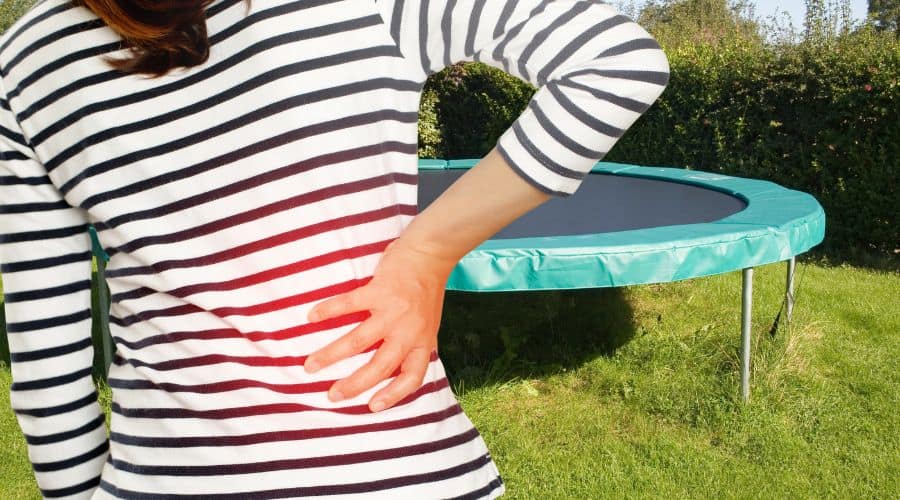Trampoline accidents cause over 100,000 hospital visits annually, many of which are for back injuries. Yet orthopedic surgeons recommend jumping on trampolines after many surgeries, including back surgery. That doesn’t seem to make sense, but I can explain why.
Are Trampolines bad for your back? Read on, and I’ll teach you everything you need to know to enjoy jour bouncing safely, so you don’t have back pain and problems.
Training on a trampoline is significantly less dangerous to use than other forms of exercise and training. Bouncing or rebounding is an excellent exercise for your muscles, cardiovascular system, and bones, but only when you’re careful. There are 100,000 hospital visits annually for trampoline injuries, the majority are children, and at least half are falling accidents.
Table of Contents
Is Jumping On A Trampoline Bad For Your Back
Jumping on a trampoline is not bad for your back, which is why surgeons may recommend this activity after surgery.
Far from causing damage, the bouncing actually relieves pressure. Even moderate to slight bouncing can help strengthen the muscles in your back.
When done correctly, trampolining is known for its benefits. The trick is to do it safely and not go overboard.
Here’s a list of how jumping on a trampoline can help improve your health and back.
- Relieves pressure
- Aids in balance
- Improves coordination
- Helps with motor skills
- Muscle gains, especially in the legs, core, back, and glutes
- Positive effects on bone strength and density
- Fun and relaxing, so it relieves stress
Can You Hurt Your Back On A Trampoline
You can hurt your back on a trampoline, but then again, you can damage your back doing almost anything if you do it excessively or badly.
The size of the trampoline certainly matters. Using the miniature home rebounders designed for exercise is typically the safest and offers the slightest bounce.
The largest backyard trampolines are the most common. Additionally, they’re higher off the ground and have more bounce, so these cause a lot of injuries.
Meanwhile, back injuries at trampoline parks have been on the rise because the popularity of trampoline parks is going up.
When bouncing on the super-sized, ultra-springy mats, it is easy to get extreme air, which means coming back down hard and fast. You don’t have to miss much to hurt your back.
The thing almost all trampoline injuries have in common is user error. The trampolines are rarely to blame.
A solidly built trampoline can help anyone exercise, but it’s so much fun that people, especially younger people, lose focus and forget about the risk.
Upper Back Pain After Jumping On Trampoline
Most muscular pain that happens after jumping on a trampoline comes from excess. If you overdo it, you can end up with sore muscles, strains, and even injuries.
Your upper back would be no exception, especially if you spent a lot of time throwing your arms up or moving them around.
Chest pain can also contribute to upper back pain after jumping on a trampoline.
Exercise-induced bronchospasm or EIB is minor lung spasms that can cause pain. Since our lungs are inside the upper chest cavity, this can manifest as chest pain, back pain, or both.
Middle Back Pain From Trampoline
Pulling too quickly, too hard, or both on your muscles can cause muscle strain and pain.
What that means for middle back pain after jumping on a trampoline is that you went too hard.
Try slowing down and making smaller jumps to help relieve pressure without causing more pain, but if you have serious aches, the damage may already be done, and you should stop until it heals.
People with herniated discs and other pre-existing back problems should not jump on trampolines, especially the large ones unless directed by a doctor or physical therapist.
There is a significant difference between a controlled atmosphere like jumping in physical therapy where a professional monitors you and going wild on a home or trampoline park trampoline.
Child Back Pain After Trampoline
Tens of thousands of children get injured jumping on trampolines every year. You should always take child back pain after jumping on a trampoline seriously.
Most young jumpers get back injuries when they bounce wildly, doing flips, and landing badly on their neck or back instead of their feet.
If you suspect your child has damaged their back while jumping, have them stop immediately and go see the doctor or head to your local ER in more severe cases.
What Helps A Sore Back From Jumping On A Trampoline
There are plenty of ways to help a sore back from jumping on a trampoline. The first thing you should do is stop jumping.
If it is causing pain, then you have a problem, and you may want to consult a physician or slow down on the trampolining.
Below is a list of ways to help your sore back.
- Always stretch before and after rebounding.
- Work on landing softly and on your feet as you jump.
- When using a mini trampoline indoors, skip exercises that have one leg on the floor as this can cause heavier impacts and pain.
- Get a massage done by a professional
- Remember to stay hydrated because your joints and muscles need water to stay healthy and function properly.
- Get plenty of sleep, and try sleeping with a knee pillow, so your spine is in the correct position as you rest.
- According to Good RX, ” Ice and heat therapy can both be effective treatment options for muscle aches and pains. Generally, ice is better for acute or newer injuries, while heat is better for chronic or long-term pain.”
- Discuss your pain with your primary care physician and see if they have any suggestions
How To Get Rid Of Back Pain From Trampoline
Getting rid of back pain from a trampoline can be tricky. If you have significant injuries, then a hospital visit is in order.
There they may give you pain killers or recommend OTC pain killers like Tylenol and Asprin along with other instructions. It’s vital to follow your doctor’s orders.
Another great way to reduce back and body pain is through stretching and yoga.
I recommend checking out this video from Mady Morrison for gentile back pain relief.
In the video, she walks you through a series of movements to help reduce stress, stretch your back and relieve pain.
Helpful Tips To Know About If Trampolines Are Bad For Your Back
Trampolines are not bad for your back and can be helpful with numerous conditions. However, too much, too fast, and too hard jumping can easily have the opposite effect or even cause more damage.
Here are some helpful tips to know about if trampolines are bad for your back.
- Trampolines are a tool and a toy that are not inherently good or bad. Trampolines can help with everything from bone density loss to back pain relief. The question is whether you can and will use a trampoline properly.
- Many professional athletes use trampolines as a part of their training.
- Trampolines are generally meant for one person who has a spotter watching them. Take turns to avoid crashing into each other.
- The most important thing to keep in mind when you are trampolining is that your technique is everything. One bad jump with a worse landing can irreparably damage your spine, but lots of smaller, more stable bounces are frequently a part of physical therapy. Unless you are training to be an Olympic athlete or a circus performer, there’s no good reason to master a triple back flip, but a dozen great reasons to enjoy plenty of regular, smaller jumps.
Final Thoughts
Trampolines are not bad for your back but being incautious or overzealous certainly can be. It is vital to use trampolines properly and work on your technique.
If you have back problems already, please consult your doctor or physical therapist before jumping.
Trampolining can help increase bone density, strengthen muscles and relax your back when you do it correctly.
Instead of trying for the world backflip record, consider scaling it back to what your body can handle, and remember to stretch and stay hydrated.

